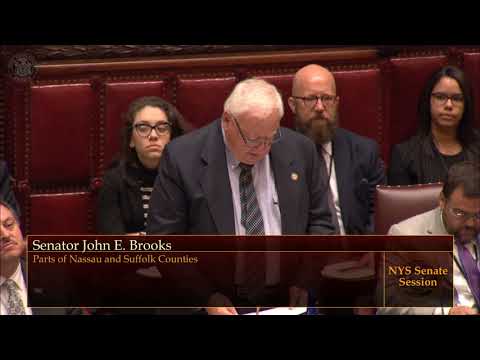
Brooks Calls School Funding System ‘Unfair’

State Sen. John Brooks recently sponsored a bill that could reshape the way Long Island’s public schools are funded.
Senate Bill S1687, which was passed by the Senate during the final days of the legislative session, calls for a task force to analyze the current funding system for primary and secondary education. The goal, the Seaford Democrat said, is to publish a study and propose a new system that is state-funded through income taxes rather than the current practice of using property taxes.
The current system, Brooks said, is “unfair.”
“The challenges facing education are dramatically changing,” Brooks said on Monday. “The way we fund education is presenting significant problems. We have an overdependence on residential property taxes.”
Every year in their proposed budgets, school districts announce their tax levies — the amount of property taxes that need to be collected to meet a district’s expenses. In school systems with low commercial tax bases, Brooks said, residential property taxes can account for as much as 80 percent of the budget. On the Bellmore-Merrick Central High School District’s 2019-20 “property tax report card,” for example, residents accounted for more than $119 million of the total $163 million budget, or roughly 73 percent.
As an example, Brooks offered two hypothetical homeowners, each with residential property with an assessed value of $500,000. In the case of Homeowner A, the property was inherited or the mortgage paid off. But Homeowner B is a first-time buyer who financed all but 3 percent of the home’s assessed value and has a mortgage for the rest. Current models neither account for such disparities in homeowners’ equity nor take into account differences in income, making property tax regressive. Income taxes take at least some of these disparities into account.
Geographically, the quality of education is also affected. Malls, offices and other businesses within school districts also relieve residential taxpayers’ burdens. The commercial property taxes that are funneled into those districts act as a “significant help” for school funding, Brooks said.
“A district with little to no commercial property taxes,” he added, “is going to have a significant tax liability in [residential] property taxes.”
Seniors are disadvantaged as well, he said, because they might be taxed based on the value of their home — an asset value — despite being retired. “We’re saying that the value of their house is a pure indication of their financial position,” Brooks said, “when it’s not.”
His concerns grew out of an independent, comprehensive examination of how every school district in the state is funded and the educational disparities among them.
“What we need to do is take a step back, re-examine the role of education and figure out how we can change this,” Brooks said, “so that every student, regardless of where they live, has an opportunity for a quality education.”
The amount of money from the state, he explained, would suffice to meet school requirements. If districts wanted to spend more, they would still have the option to do so under a new system. Just like propositions in the current budgets, districts can ask taxpayers to vote on and approve extended measures and programs that would be funded by property taxes.
Jeff Gold, a Bellmore tax lawyer who is a public advocate for Nassau County’s current property reassessment initiative, said the idea raises concerns. While he would like to wait and see what the final study proposes, Gold said, it “may hurt as many people as it helps.” Higher-income residents may have to pay a larger share if a new income-based rate does not have a cap.
“It raises a lot of issues,” Gold said, because for a school district such as Bellmore, funding the system through income is feasible. For others, it may be more of a burden.
The task force, which would include school officials and educators, would have three years to complete its study. At the end of their research, which could happen sooner than the deadline, Brooks said, a report would be published, offering best recommendations, according to the bill.
The task force would also have a dedicated website, where its findings would be posted, and a public comment section would be available.



